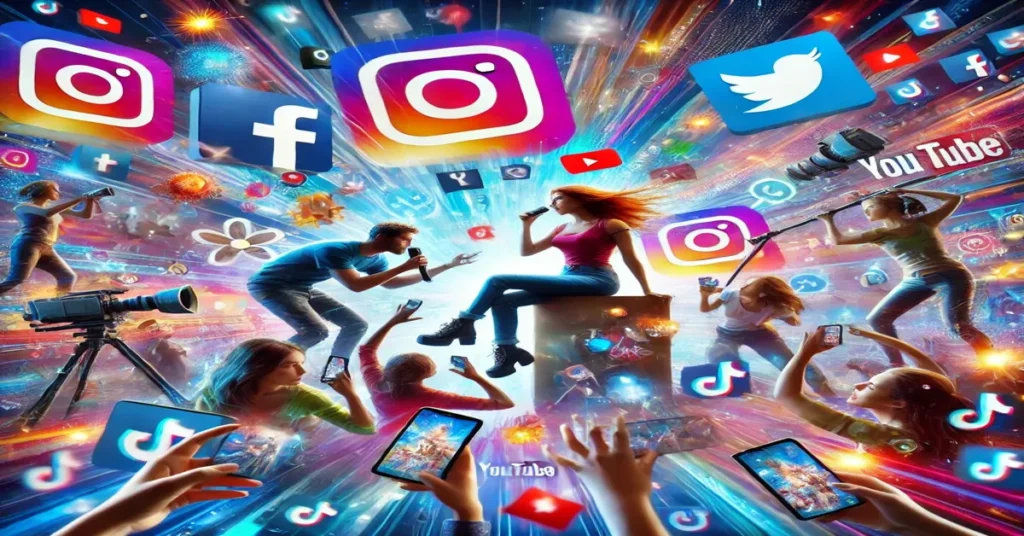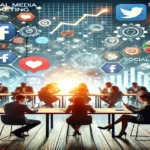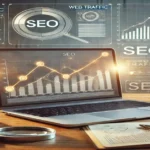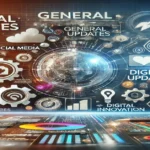Social media has dramatically changed the way people consume content and interact with public figures. Platforms such as Instagram, YouTube, TikTok, and Twitter (now X) have provided a stage for influencers—individuals who create content and garner large followings. These influencers can affect consumer behavior, opinions, and trends. However, with this rise of influence comes the darker side, which is often referred to as “ImfluencersGoneWild.”
This article delves into the phenomenon of influencers, their rise to fame, their impact on society, and the scandals and controversies that have led to the term “ImfluencersGoneWild.” We will explore how these public figures, once ordinary people, have turned social media into a career, how they influence public perception, and the consequences of unbridled stardom.
1. Who Are Influencers?
1.1. The Definition of an Influencer
Influencers are individuals who have amassed a significant number of followers on social media platforms. They can influence public opinions (ImfluencersGoneWild), trends, or purchasing decisions due to their perceived authority, knowledge, or relatability in a particular niche. Influencers typically focus on topics such as fashion, fitness, beauty, travel, food, or technology, where they curate content that appeals to a specific audience.
1.2. Different Types of Influencers
- Micro-Influencers: These individuals have smaller followings, usually between 10,000 to 100,000, but they tend to have highly engaged and niche audiences.
- Macro-Influencers: These influencers have more substantial followings, ranging from 100,000 to over a million. They reach a broader audience and have substantial brand collaboration opportunities.
- Mega-Influencers: With millions of followers, mega-influencers, often celebrities or widely recognized figures, command massive attention. Their content frequently goes viral, and they often work with high-end brands.
- Niche Influencers: These influencers focus on a specific topic or field, such as environmental activism, veganism, tech reviews, or personal finance. Their followers see them as subject-matter experts.
2. The Rise of Social Media Influencers
2.1. The Role of Social Media in Influencer Growth
The rise of influencers (ImfluencersGoneWild) is tied directly to the advent of social media platforms that prioritize visual and interactive content. Platforms such as Instagram, TikTok, YouTube, and X have enabled influencers to cultivate personal brands, bypassing traditional media outlets like television or magazines. The accessibility of social media allows influencers to connect directly with their audience, creating a sense of authenticity and trust that traditional media often lacks.
2.2. Monetizing Influence
Many influencers have turned their online personas into profitable careers. They monetize their influence through:
- Sponsored Content: Collaborating with brands to promote products or services.
- Affiliate Marketing: Earning commissions from promoting products or services, often through referral links.
- Merchandising: Selling branded merchandise to fans, from clothing to accessories.
- Exclusive Content: Offering fans access to premium content via platforms like Patreon, OnlyFans, or exclusive YouTube memberships.
2.3. Influencer Marketing’s Impact on Businesses
Brands have recognized the power of influencers to reach targeted demographics, especially younger audiences. Influencer marketing has become an integral part of many companies’ marketing strategies, allowing them to showcase products authentically through trusted figures – ImfluencersGoneWild.
According to a study by Influencer Marketing Hub, businesses made an average of $5.20 for every $1 spent on influencer marketing in 2023. This high return on investment makes influencer collaborations an attractive proposition for businesses – ImfluencersGoneWild.
3. The Dark Side of Influencer Fame
3.1. The Pressure to Maintain Relevance
The life of an influencer, while often portrayed as glamorous, is not without its challenges. The constant need to stay relevant in the fast-paced world of social media can put immense pressure on influencers. To keep their audiences engaged, influencers must regularly create new content, stay up-to-date on trends, and maintain a polished online persona (ImfluencersGoneWild). This pressure has led some influencers to engage in risky or controversial behavior to maintain or boost their popularity.
3.2. The Controversies of Influencers Gone Wild
The term “ImfluencersGoneWild” often refers to the negative side of influencer culture. Many influencers, in the quest for more followers, fame, or financial gain, have been involved in various scandals and controversies. These can range from unethical behavior, cultural appropriation, and false advertising, to criminal activities.
3.2.1. Ethical Violations and False Advertising
One of the most significant issues in the influencer world is false advertising. Influencers, driven by financial incentives, sometimes promote products they do not believe in or have not used themselves. This leads to accusations of being “sellouts,” (ImfluencersGoneWild) where influencers prioritize profits over authenticity.
Additionally, some influencers have been caught manipulating their audience by promoting products with exaggerated claims, such as weight loss supplements, detox teas, or dubious skincare products.
3.2.2. Social Media Feuds and Drama
Social media platforms are rife with influencer feuds and “cancel culture,” where influencers get publicly called out for offensive behavior, past statements, or controversial actions. These feuds, while sometimes staged for attention, can cause significant damage to an influencer’s reputation – ImfluencersGoneWild.
One example of influencers gone wild is the frequent clashes between beauty influencers on YouTube. Public spats between major influencers, such as Tati Westbrook and James Charles, generated widespread attention, leading to massive follower losses and public apologies – ImfluencersGoneWild.
3.2.3. Cultural Appropriation and Insensitivity
Another frequent controversy is the issue of cultural appropriation. Influencers (ImfluencersGoneWild) who borrow elements of a culture that is not their own, without understanding its significance or giving proper credit, often face backlash. This practice can offend entire communities and damage an influencer’s standing.
One example is when influencers appropriate sacred cultural symbols for fashion or aesthetics, leading to accusations of exploitation and insensitivity.
3.2.4. Exploiting Followers and Mental Health Issues
Some influencers have been criticized for taking advantage of their followers by selling overpriced or low-quality products, scamming their audience, or engaging in fraudulent activities. The lines between genuine content and financial manipulation can sometimes blur, leading to mistrust.
The mental health of influencers is another area of concern. The pressure to maintain a certain image, constantly engage with their audience, and deal with online criticism can take a significant toll on influencers’ mental well-being (ImfluencersGoneWild). Many influencers have spoken openly about burnout, depression, and anxiety resulting from the demands of their career.
4. The Consequences of Influencers Gone Wild
4.1. Public Backlash and “Cancel Culture”
The rise of “cancel culture” has become a significant part of the influencer ecosystem. When influencers engage in problematic behavior, they often face public backlash, losing followers, sponsorship deals, and even their careers. The consequences of such scandals can be severe, leading to long-term damage to an influencer’s reputation -ImfluencersGoneWild.
Examples include high-profile cases such as the downfall of fitness influencer Brittany Dawn, who was accused of selling fraudulent fitness plans, and Logan Paul, who faced intense criticism after posting a video featuring a deceased individual in Japan’s Aokigahara forest.
4.2. Legal Implications
Some influencers have faced legal consequences for their actions. This includes lawsuits for false advertising, defamation, breach of contract, and copyright infringement (ImfluencersGoneWild). Additionally, influencers who promote harmful products or services may face penalties from regulatory agencies like the Federal Trade Commission (FTC) in the U.S., which mandates that sponsored content be disclosed clearly.
One famous example involves Kim Kardashian, who was fined by the Securities and Exchange Commission (SEC) for failing to properly disclose her promotion of a cryptocurrency product on her social media platforms.
5. Influencer Accountability and Regulation
5.1. Growing Demand for Transparency
As influencer marketing becomes more prevalent, there has been a growing demand for transparency and accountability. Platforms like Instagram and YouTube have introduced policies requiring influencers to disclose sponsored content explicitly (ImfluencersGoneWild). Governments and regulatory agencies have also stepped in to monitor influencer behavior and ensure that consumers are not misled.
In 2023, the FTC tightened its guidelines regarding endorsements and sponsorships, requiring influencers to disclose their financial relationships with brands in a clear and conspicuous manner. Failure to comply can result in hefty fines – ImfluencersGoneWild.
5.2. Ethical Considerations for Influencers
To combat the “influencers gone wild” narrative, many influencers are now focusing on ethical practices and authenticity. They are becoming more mindful of the products and services they promote, taking care to maintain the trust of their audience (ImfluencersGoneWild). Influencers are also more likely to use their platforms for social good, raising awareness about important issues such as climate change, mental health, and social justice.
Influencers who take their responsibility seriously tend to have long-lasting careers and stronger, more loyal followings (ImfluencersGoneWild). They understand that their success is built on the trust of their audience, and they strive to maintain that trust by being transparent, responsible, and ethical in their content creation.
6. The Future of Influencers: A Balanced Approach
6.1. The Evolution of Influencer Marketing
As the influencer industry continues to evolve, there will likely be a shift toward more responsible and accountable content creation. Influencers will need to find a balance between engaging content and ethical practices to maintain credibility in the long run (ImfluencersGoneWild).
In addition, influencer marketing will become more data-driven, with brands relying on analytics to measure the impact of collaborations. Artificial intelligence (AI) and machine learning tools will help brands identify the right influencers for their campaigns, ensuring better-targeted marketing efforts.
6.2. Influencers as Thought Leaders
Many influencers are now transcending the traditional boundaries of social media fame. Some are becoming thought leaders, using their platforms to share valuable insights on politics, social issues, and other important topics. By embracing a more meaningful and purpose-driven approach, influencers can have a positive impact on society and create long-lasting legacies.
Conclusion
The world of social media influencers is complex and ever-changing. While influencers have revolutionized how brands connect with consumers and how individuals express themselves online, the phenomenon of “influencers gone wild” has highlighted the risks associated with fame and influence. From false advertising and unethical behavior to the mental health toll of maintaining a public persona, the challenges influencers face are significant.
However, as the industry matures, there is hope for more accountability and transparency. Influencers who prioritize authenticity, responsibility, and ethical practices are more likely to enjoy long-term success and positive reputations.
FAQs
1. What does “influencers gone wild” mean?
“Influencers gone wild” refers to influencers engaging in controversial or unethical behavior, often resulting in public backlash. This includes actions like false advertising, cultural appropriation, and other scandals that damage their reputation.
2. How do influencers make money?
Influencers typically make money through sponsored content, affiliate marketing, merchandise sales, and premium content. Some also earn income through advertising revenue on platforms like YouTube or exclusive platforms like OnlyFans.
3. What is influencer marketing?
Influencer marketing is a strategy where brands collaborate with influencers to promote products or services. This marketing technique leverages the influencer’s reach and trust with their audience to drive consumer behavior.
4. How can influencers avoid backlash?
Influencers can avoid backlash by being transparent about their relationships with brands, promoting only products they genuinely believe in, respecting cultural boundaries, and maintaining ethical practices in their content creation.
5. What are the legal requirements for influencers regarding sponsored content?
In many countries, including the U.S., influencers must disclose when content is sponsored. This includes using hashtags like #ad or #sponsored and ensuring that the disclosure is clear and conspicuous in their posts.
6. How does “cancel culture” affect influencers?
Cancel culture can significantly impact influencers by causing them to lose followers, brand deals, and reputation. It occurs when an influencer faces widespread criticism for controversial actions, leading to public shaming and career setbacks.
4o







